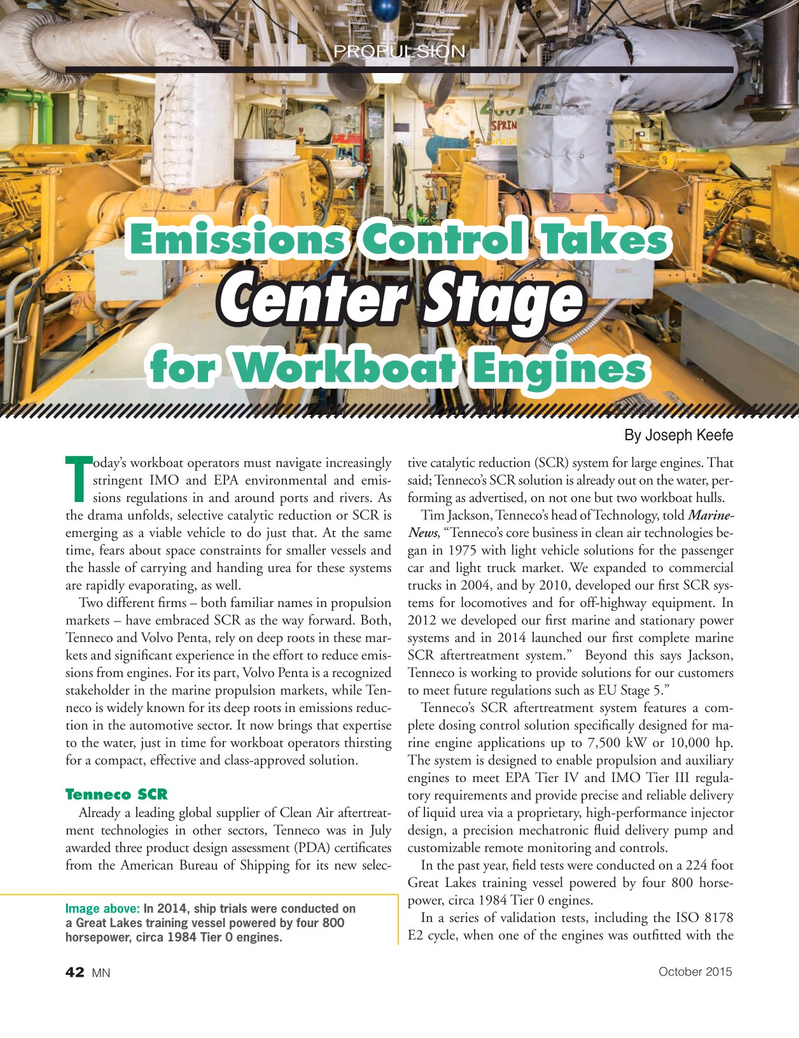
Page 42: of Marine News Magazine (October 2015)
Salvage & Spill Response
Read this page in Pdf, Flash or Html5 edition of October 2015 Marine News Magazine
PROPULSION
Emissions Control Takes
Center Stage for Workboat Engines
By Joseph Keefe oday’s workboat operators must navigate increasingly tive catalytic reduction (SCR) system for large engines. That stringent IMO and EPA environmental and emis- said; Tenneco’s SCR solution is already out on the water, per- sions regulations in and around ports and rivers. As forming as advertised, on not one but two workboat hulls.
T the drama unfolds, selective catalytic reduction or SCR is Tim Jackson, Tenneco’s head of Technology, told Marine- emerging as a viable vehicle to do just that. At the same News, “Tenneco’s core business in clean air technologies be- time, fears about space constraints for smaller vessels and gan in 1975 with light vehicle solutions for the passenger the hassle of carrying and handing urea for these systems car and light truck market. We expanded to commercial are rapidly evaporating, as well. trucks in 2004, and by 2010, developed our ? rst SCR sys-
Two different ? rms – both familiar names in propulsion tems for locomotives and for off-highway equipment. In markets – have embraced SCR as the way forward. Both, 2012 we developed our ? rst marine and stationary power
Tenneco and Volvo Penta, rely on deep roots in these mar- systems and in 2014 launched our ? rst complete marine kets and signi? cant experience in the effort to reduce emis- SCR aftertreatment system.” Beyond this says Jackson, sions from engines. For its part, Volvo Penta is a recognized Tenneco is working to provide solutions for our customers stakeholder in the marine propulsion markets, while Ten- to meet future regulations such as EU Stage 5.” neco is widely known for its deep roots in emissions reduc- Tenneco’s SCR aftertreatment system features a com- tion in the automotive sector. It now brings that expertise plete dosing control solution speci? cally designed for ma- to the water, just in time for workboat operators thirsting rine engine applications up to 7,500 kW or 10,000 hp. for a compact, effective and class-approved solution. The system is designed to enable propulsion and auxiliary engines to meet EPA Tier IV and IMO Tier III regula-
Tenneco SCR tory requirements and provide precise and reliable delivery
Already a leading global supplier of Clean Air aftertreat- of liquid urea via a proprietary, high-performance injector ment technologies in other sectors, Tenneco was in July design, a precision mechatronic ? uid delivery pump and awarded three product design assessment (PDA) certi? cates customizable remote monitoring and controls.
from the American Bureau of Shipping for its new selec- In the past year, ? eld tests were conducted on a 224 foot
Great Lakes training vessel powered by four 800 horse- power, circa 1984 Tier 0 engines.
Image above: In 2014, ship trials were conducted on
In a series of validation tests, including the ISO 8178 a Great Lakes training vessel powered by four 800
E2 cycle, when one of the engines was out? tted with the horsepower, circa 1984 Tier 0 engines.
October 2015 42 MN
MN Oct15 Layout 32-49.indd 42 9/21/2015 11:25:53 AM

 41
41

 43
43
